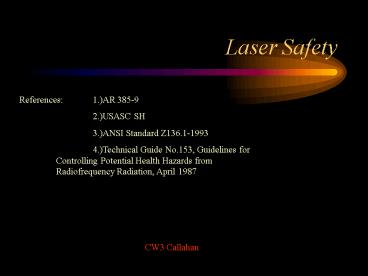Laser Safety - PowerPoint PPT Presentation
1 / 16
Title:
Laser Safety
Description:
LASER is a source of intense, coherent and directional optical radiation. ... Require countermeasures to prevent exposure including eyewear and clothing. ... – PowerPoint PPT presentation
Number of Views:338
Avg rating:3.0/5.0
Title: Laser Safety
1
Laser Safety
References 1.)AR 385-9 2.)USASC SH 3.)ANSI
Standard Z136.1-1993 4.)Technical Guide No.153,
Guidelines for Controlling Potential Health
Hazards from Radiofrequency Radiation, April
1987
CW3 Callahan
2
Definition
LASER is a source of intense, coherent and
directional optical radiation. Also, an acronym
for Light Amplification by Stimulated Emission of
Radiation. In common usage, a laser is a device
that produces an intense, narrow beam of light.
Normally each laser can only produce a single
frequency or color of radiation. However, there
are many different types of lasers. Some produce
light which is in the visible frequency spectrum.
3
Laser Types
- Class 1
- Class 2
- Class 3
- Class 4
- Class 5
4
Class 1
- Lasers not capable of emitting hazardous
radiation under any operating or viewing
conditions. May be enclosed. - REQUIREMENTS Labeling
- Interlocks on case
5
Class 2
- Continuous wave, low power visible lasers.
- Avoid staring continuously into the beam.
- MOMENTARY exposure is not considered hazardous
- REQUIREMENTS Labeling
- Caution do not stare directly into beam
6
Class 3a
- GENERALLY not hazardous unless beam is viewed
with magnifying optics - (Eyeglasses, etc.)
7
Class 3b
- Potentially hazardous if the direct or specularly
reflected beam is viewed by the unprotected eye. - Does not pose a diffuse reflection hazard.
- Avoid direct viewing and specular (mirror-like)
reflections.
8
Class 3 4 Requirements
- Labeling
- Operate on approved laser range only
- Lase only approved targets
- Use a laser backstop
- Use eye protection in target area
- Use warning signs
9
Class 3a b
- Pen type laser pointers
- Hazard to unprotected eye of individuals looking
directly at the beam. - Caution label
- Blink reflex is theoretically enough protection
to avoid damage. - Danger label
- Momentary viewing can exceed threshold limits.
10
Class 4
- Pulsed visible and near-IR
- Capable of producing diffuse reflection, fire and
skin hazards - Require countermeasures to prevent exposure
including eyewear and clothing. - General safety requirements same as Class 3
11
Class 5
- Not in standard military use
- Capable of burning objects directly exposed to
energy
12
OH-58D MMS
- Most powerful production laser in military use
- Class IV
- Nominal Ocular Hazard Distance
- 23 km for a single pulse
- 35 km for multiple pulses
- 56 km for a single pulse viewed through optics!
13
OH-58D MMS
- System Safety Features of the MMS
- No direct view optics (binos)
- Environmental cover may be used to contain LE
- Boresight module is completely enclosed
- Beam exit port is far above eye level
- Laser ground sensor prevents lasing unless rotor
speed is at or above 95 - Laser fire button must be continually pressed to
continue firing
14
Medical Requirements
- ANSI Standard Z136.1-1993, 3.3.3.2
- Vision/Ocular assessments are required for
personnel using Class 3b and Class 4 lasers and
laser systems - Immediate opthalmic exams will be performed when
there is a known or suspected laser overexposure.
15
Symptoms of Injury
- Reduction in visual acuity
- Pain
- Seeing bright flashes
- Coneal burns (visible)
- Retinal hemorrhage
- Irritated skin
- Spontaneous fires and damage to optical
instruments (NVGs)are evidence of possible laser
employment.
16
Questions?

